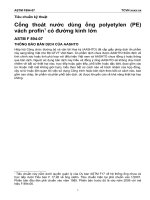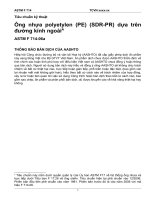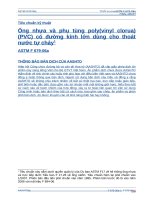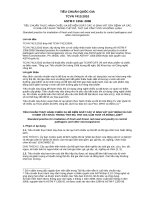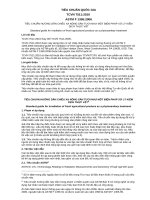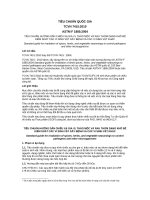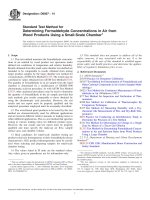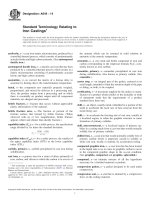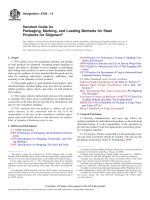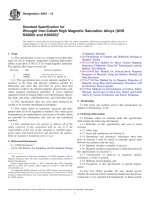Astm f 382 14
Bạn đang xem bản rút gọn của tài liệu. Xem và tải ngay bản đầy đủ của tài liệu tại đây (286.42 KB, 13 trang )
Designation: F382 − 14
Standard Specification and Test Method for
Metallic Bone Plates1
This standard is issued under the fixed designation F382; the number immediately following the designation indicates the year of original
adoption or, in the case of revision, the year of last revision. A number in parentheses indicates the year of last reapproval. A superscript
epsilon (´) indicates an editorial change since the last revision or reapproval.
using all of the described methods. Instead, the user should
only select test methods that are appropriate for a particular
device design. In most instances, only a subset of the herein
described test methods will be required.
1.7 This standard does not purport to address all of the
safety concerns, if any, associated with its use. It is the
responsibility of the user of this standard to establish appropriate safety and health practices and determine the applicability of regulatory limitations prior to use.
1. Scope
1.1 This specification and test method is intended to provide
a comprehensive reference for bone plates used in the surgical
internal fixation of the skeletal system. The standard establishes consistent methods to classify and define the geometric
and performance characteristics of bone plates. The standard
also presents a catalog of standard specifications that specify
material; labeling and handling requirements; and standard test
methods for measuring performance related mechanical characteristics determined to be important to the in vivo performance of bone plates.
2. Referenced Documents
2.1 ASTM Standards:2
E122 Practice for Calculating Sample Size to Estimate, With
Specified Precision, the Average for a Characteristic of a
Lot or Process
F67 Specification for Unalloyed Titanium, for Surgical Implant Applications (UNS R50250, UNS R50400, UNS
R50550, UNS R50700)
F75 Specification for Cobalt-28 Chromium-6 Molybdenum
Alloy Castings and Casting Alloy for Surgical Implants
(UNS R30075)
F86 Practice for Surface Preparation and Marking of Metallic Surgical Implants
F90 Specification for Wrought Cobalt-20Chromium15Tungsten-10Nickel Alloy for Surgical Implant Applications (UNS R30605)
F136 Specification for Wrought Titanium-6Aluminum4Vanadium ELI (Extra Low Interstitial) Alloy for Surgical
Implant Applications (UNS R56401)
F138 Specification for Wrought 18Chromium-14Nickel2.5Molybdenum Stainless Steel Bar and Wire for Surgical
Implants (UNS S31673)
F139 Specification for Wrought 18Chromium-14Nickel2.5Molybdenum Stainless Steel Sheet and Strip for Surgical Implants (UNS S31673)
F543 Specification and Test Methods for Metallic Medical
Bone Screws
F565 Practice for Care and Handling of Orthopedic Implants
and Instruments
1.2 It is not the intention of the standard to define levels of
performance or case-specific clinical performance for bone
plates, as insufficient knowledge is available to predict the
consequences or their use in individual patients for specific
activities of daily living. Futhermore, it is not the intention of
the standard to describe or specify specific designs for bone
plates used in the surgical internal fixation of the skeletal
system.
1.3 This document may not be appropriate for all types of
bone plates. The user is cautioned to consider the appropriateness of the standard in view of a particular bone plate and its
potential application.
1.4 This document includes the following test methods used
in determining the following bone plate mechanical performance characteristics:
1.4.1 Standard Test Method for Single Cycle Bend Testing
of Metallic Bone Plates—Annex A1, and
1.4.2 Standard Test Method for Determining the Bending
Fatigue Properties Of Metallic Bone Plates—Annex A2.
1.5 The values stated in SI units are to be regarded as
standard. No other units of measurement are included in this
standard.
1.6 Multiple test methods are included in this standard.
However, it must be noted that the user is not obligated to test
1
This specification and test method is under the jurisdiction of ASTM Committee F04 on Medical and Surgical Materials and Devices and is the direct
responsibility of Subcommittee F04.21 on Osteosynthesis.
Current edition approved Nov. 1, 2014. Published January 2014. Originally
approved in 1973. Last previous edition approved in 2008 as F382 – 99 (2008)ε1.
DOI: 10.1520/F0382-14.
2
For referenced ASTM standards, visit the ASTM website, www.astm.org, or
contact ASTM Customer Service at For Annual Book of ASTM
Standards volume information, refer to the standard’s Document Summary page on
the ASTM website.
Copyright © ASTM International, 100 Barr Harbor Drive, PO Box C700, West Conshohocken, PA 19428-2959. United States
1
F382 − 14
FIG. 1 Bone Plate Cross-sections
3.1.2 bone plate—a metallic device with two or more holes
or slot(s), or both, and a cross section that consists of at least
two dimensions (width and thickness) which generally are not
the same in magnitude. The device is intended to provide
alignment and fixation of two or more bone sections, primarily
by spanning the fracture or defect. The device is typically fixed
to the bone through the use of bone screws or cerclage wire. A
partial list of general types of bone plates is given in Section
4.1.
F620 Specification for Titanium Alloy Forgings for Surgical
Implants in the Alpha Plus Beta Condition
F621 Specification for Stainless Steel Forgings for Surgical
Implants
F983 Practice for Permanent Marking of Orthopaedic Implant Components
F1295 Specification for Wrought Titanium-6Aluminum7Niobium Alloy for Surgical Implant Applications (UNS
R56700)
F1314 Specification for Wrought Nitrogen Strengthened 22
Chromium–13 Nickel–5 Manganese–2.5 Molybdenum
Stainless Steel Alloy Bar and Wire for Surgical Implants
(UNS S20910)
F1472 Specification for Wrought Titanium-6Aluminum4Vanadium Alloy for Surgical Implant Applications (UNS
R56400)
F1713 Specification for Wrought Titanium-13Niobium13Zirconium Alloy for Surgical Implant Applications
(UNS R58130)
2.2 ISO Standard:3
ISO 9585 Implants for Surgery—Determination of Bending
Strength and Stiffness of Bone Plates
ISO 14602 Non-active surgical implants—Implants for Osteosynthesis particular requirements.
3.1.3 bone plate length, L (mm)—the linear dimension of the
bone plate measured along the longitudinal axis as illustrated in
Fig. 2.
3.1.4 bone plate thickness, b (mm)—the linear dimension of
the bone plate measured parallel to the screw hole axis as
shown Figs. 1a, 1b, and 2. For a bone plate with a crescent
section, the thickness is measured at the thickest point along
the section.
3.1.5 bone plate width, w (mm)—the linear dimension of the
bone plate measured perpendicular to both the length and
thickness axes as shown in Fig. 2.
3.1.6 contouring—the manipulation and bending of a bone
plate, either pre-operatively or intra-operatively, to match the
anatomic geometry of the intended fixation location.
3.1.7 crescent section—a bone plate cross-section shape
(perpendicular to the long axis of the bone plate) where the
thickness is not constant along the section. Typically the
section is thickest along the bone plate’s centerline and tapers
to a smaller thickness at the bone plate’s edges (see Fig. 1b).
3. Terminology
3.1 Definitions—Geometric:
3.1.1 auto compression—a type of bone plate that by its
design can generate a compressive force between adjacent
unconnected bone fragments through the use of one or more
ramped holes or another type of slot geometry. This ramp or
slot geometry contacts the underside of the screw head, and
induces compressive force as the screw is inserted and tightened to the bone plate.
3.1.8 uniform width—referring to a bone plate where the
width is constant along the bone plate’s length.
3.2 Definitions—Mechanical/Structural:
3.2.1 bending stiffness, K (N/mm)— of a bone plate, the
maximum slope of the linear elastic portion of the load versus
load-point displacement curve for a bone plate when tested
according to the test method of Annex A1.
3
Available from American National Standards Institute (ANSI), 25 W. 43rd St.,
4th Floor, New York, NY 10036, .
2
F382 − 14
FIG. 2 Bone Plate Dimensions
4.1.2 Cobra Head Plate—A bone plate that has one flared
triangular or trapezoidal end which contains multiple screw
holes or slots, or both. This type of bone plate is often used for
hip arthrodesis.
4.1.3 Reconstruction Plate—A bone plate that does not have
a uniform width, but usually has a smaller cross-section
between the screw holes or slots. The reduced cross-section
between screw holes/slots facilitates contouring the bone plate
in several planes. Reconstruction plates are often used in
fractures of the pelvis and acetabulum.
4.1.4 Straight Plate—A bone plate with uniform width and
a straight longitudinal axis. Straight plates are often used for
fractures of the diaphyses of long bones.
4.1.5 Tubular Plate—A bone plate whose cross-section
resembles a portion of a tube, and which has a constant
thickness or a crescent section. Tubular plates are often used
for fractures of the smaller long bones (that is, radius, ulna,
fibula).
3.2.2 bending strength (N-m)— of a bone plate, the bending
moment necessary to produce a 0.2 % offset displacement in
the bone plate when tested as described in Annex A1.
3.2.3 bending structural stiffness, El (N-m2)—of a bone
plate, the bone plate’s normalized effective bending stiffness
that takes into consideration the effects of the test setup’s
configuration when tested according to the method described in
Annex A1.
3.2.4 fatigue life, n—the number of loading cycles of a
specified character that a given specimen sustains before
failure of a specified nature occurs.
3.2.5 fatigue strength at N cycles—An estimate of the cyclic
forcing parameter (for example, load, moment, torque, stress,
and so on) at a given load ratio, for which 50 % of the
specimens within a given sample population would be expected to survive N loading cycles.
4. Classification
4.1 Bone plates used in general orthopaedic surgery can be
categorized into general types according to the following
classifications:
4.1.1 Cloverleaf Plate—A bone plate that has one threelobed end which contains screw holes.
5. Marking, Packaging, Labeling, and Handling
5.1 Dimensions of bone plates should be designated by the
standard definitions given in Section 3.1.
3
F382 − 14
having ASTM specifications can be found in the list of
referenced ASTM standards of Section 2.1.
6.2 Bone plates of forged Specification F136 shall meet the
requirements of Specification F620.
6.3 Bone plates of forged Specification F138 shall meet the
requirements of Specification F621.
5.2 Bone plates shall be marked using a method specified in
accordance with either Practice F983 or ISO 14602 ISO 14602.
5.3 Markings on bone plates shall identify the manufacturer
or distributor and shall be located away from the most highly
stressed areas, where possible.
5.4 Packaging shall be adequate to protect the bone plates
during shipment.
7. General Requirements and Performance
Considerations
7.1 Geometric Considerations—Bone plates that are intended to be used with bone screws shall have design features
(screw holes or slots) that conform or appropriately fit the
corresponding bone screw.
7.2 Pending Properties—This is a critical characteristic of
bone plates for orthopedic applications since the bone plate
provides the primary means of stabilizing the bone fragments.
Additionally, the bending stiffness of the bone plate may
directly affect the rate and completeness of healing.
7.2.1 The relevant bending properties (bending stiffness,
bending structural stiffness, and bending strength) shall be
determined using the standard test method of Annex A1.
7.2.2 The relevant bending fatigue properties shall be determined in accordance with the methods described in Annex A2.
5.5 Package labeling for bone plates shall include when
possible the following information:
5.5.1 Manufacturer and product name;
5.5.2 Catalog number;
5.5.3 Lot or serial number;
5.5.4 Material and, where applicable, its associated ASTM
specification designation number;
5.5.5 Number of screw holes;
5.5.6 Bone plate width;
5.5.7 Bone plate length;
5.5.8 Bone plate thickness; and
5.5.9 ASTM specification designation number.
5.6 Bone plates should be cared for and handled in accordance with Practice F565, as appropriate.
6. Materials
8. Keywords
6.1 All bone plates made of materials which have an ASTM
committee F04 standard designation shall meet those requirements given in the ASTM standards. A majority of materials
8.1 bend testing—surgical implants; fatigue test; bone plate;
orthopedic medical devices—bone plates; surgical devices; test
methods—surgical implants
ANNEXES
A1. STANDARD TEST METHOD FOR SINGLE CYCLE BEND TESTING OF METALLIC BONE PLATES1
may be identified through such methods as hand calculations,
Finite Element Analysis, etc. Screw holes or other interlocking
features or contoured regions may be located at the proximal or
distal extremities of a bone plate, and may result in structurally
critical regions at these locations.
A1.1 Scope:
A1.1.1 This test method describes methods for single cycle
bend testing in order to determine the intrinsic, structural
properties of metallic bone plates. The test method measures
the bending stiffness, bending structural stiffness, and bending
strength of bone plates.
A1.1.4 Units—The values stated in SI units are to be
regarded as standard. No other units of measurement are
included in this standard.
A1.1.2 This test method is intended to provide a means to
characterize mechanically different bone plate designs. It is not
the intention of this standard to define levels of performance
for bone plates as insufficient knowledge is available to predict
the consequences of the use of particular bone plate designs.
A1.1.5 This standard does not purport to address all of the
safety concerns, if any, associated with its use. It is the
responsibility of the user of this standard to establish appropriate safety and health practices and determine the applicability of regulatory limitations prior to use.
A1.1.3 This test method is intended to evaluate the bending
strength, bending structural stiffness, or the bending stiffness of
the bone plate, and may not be appropriate for all situations.
When the structurally critical region of the bone plate is shown
to be located through a non-uniform region of the bone plate
(i.e., a peri-prosthetic, contoured plate), it may be necessary to
evaluate the bending strength, bending structural stiffness, or
bending stiffness of this region of the bone plate using a
different test method. This is because it may not be physically
possible to fit the non-uniform region between the loading
rollers of a four-point bend test. Structurally critical regions
NOTE A1.1—There is currently an ISO standard (ISO 9585—Implants
for Surgery—Determination of Bending Strength and Stiffness of Bone
Plates) that is similar, but not equivalent to this test method.
A1.2 Referenced Documents:
A1.2.1 ASTM Standards:2
E4 Practices for Load Verification of Testing Machines
E122 Practice for Choice of Sample Size to Estimate the
Average Quality of a Lot or Process
4
F382 − 14
A1.3.1.12 total deformation (mm)—the vertical displacement of the point of application of the load when specified load
is applied.
A1.3 Terminology:
A1.3.1 Definitions:
A1.3.1.1 0.2 % offset displacement, q (mm)—permanent
deformation equal to 0.2 % of the center loading span distance.
(point B in Fig. A1.1).
A1.3.1.2 bending strength (N-m)—of a bone plate, the
bending moment necessary to produce a 0.2 % offset displacement in the bone plate when tested as described in Section
A1.8 (the bending moment corresponding to point D in Fig.
A1.1.). If the bone plate fractures before the proof point is
attained the bending strength shall be defined as the bending
moment at fracture.
A1.3.1.3 bending structural stiffness, (EIe) (N-m2)—of a
bone plate, the bone plate’s normalized effective bending
stiffness that takes into consideration the effects of the test
setup’s configuration. For this test method, the bending structural stiffness is determined from the single cycle bending
response of the bone plate and the testing configuration.
A1.3.1.4 bending stiffness, K (N/mm)—of a bone plate, the
maximum slope of the linear elastic portion of the load versus
load-point curve when tested as described in section A1.8. (See
the slope of line Om in Fig. A1.1).
A1.3.1.5 bone plate width, w (mm)—the width of the bone
plate as shown in Fig. A1.3.
A1.3.1.6 center span, a (mm)—the distance between the two
loading rollers as shown in Fig. A1.2.
A1.3.1.7 fracture load, Fmax (N)—the applied load at the
time when the bone plate fractures.
A1.3.1.8 loading span, h (mm)—the distance between the
loading roller and the nearest support as shown in Fig. A1.2.
A1.3.1.9 permanent deformation (mm)—the vertical displacement of the point of load application remaining after the
applied load has been removed.
A1.3.1.10 proof load, P (N)—the applied load at the intersection point of line. BC with the load versus load-point
displacement curve (see Fig. A1.1).
A1.3.1.11 proof point displacement (mm)—the load-point
displacement associated with the bone plate’s bending strength
(see point A in Fig. A1.1).
A1.4 Summary of Test Method:
A1.4.1 Bone plates are subjected to a single cycle four-point
bending load. The bending stiffness, bending structural
stiffness, and bending strength of the bone plate are then
derived from the test record generated during the test and the
testing configuration.
A1.5 Significance and Use:
A1.5.1 This bend test is used to determine values for the
mechanical response of bone plates to a specific type of
bending load. The information resulting from this test method
can give the surgeon some insight into the mechanical response
of a given bone plate.
A1.5.2 Since the loading on the bone plate in situ will, in
general differ from the loading configuration used in this
method, the results obtained from this test method cannot be
used directly to predict in vivo performance of the bone plate
being tested. Such mechanical property data can be used to
conduct relative comparisons of different bone plates designs.
A1.5.3 The bending strength of the bone plate, as defined in
Section A1.3.1.2, identifies the bending moment that shall be
applied to the bone plate in order to produce a specific amount
of permanent deformation.
A1.5.4 The bending structural stiffness of the bone plate, as
defined in Section A1.3.1.3, is an indicator of the bone plate’s
stiffness that is independent of the test configuration. Bending
structural stiffness is simply related to the bone plate’s geometry and the material used in manufacturing the bone plate.
A1.5.5 This test method assumes that linear-elastic material
behavior will be observed and therefore, the method is not
applicable for the testing of materials that exhibit non-linear
elastic behavior.
A1.6 Apparatus:
A1.6.1 The typical test configuration is illustrated in Fig.
A1.2.
A1.6.1.1 All loads shall be applied through rollers of equal
diameters within the range of 6 to 12 mm. The selected roller
diameter should not be greater than the distance between two
adjacent screw holes in the bone plate to be tested.
A1.6.1.2 Cylindrical rollers shall be used to test flat bone
plates and bone plates of curved cross-section, in which the
deviation from flatness at the center of the bone plate does not
exceed w/6. Test other bone plates using rollers of profiled
form corresponding to the cross-section of the bone plate to be
tested (see Fig. A1.3).
A1.6.1.3 The loading and support rollers shall be positioned
as follows:
A1.6.1.3.1 The loading rollers shall be positioned so that
two screw holes will be located between the loading rollers.
Record the center span distance.
A1.6.1.3.2 The support rollers shall be located equal distances away from the adjacent loading roller so that two screw
FIG. A1.1 Diagram Illustrating Methods for Determining the Bending Properties of Bone Plates
5
F382 − 14
FIG. A1.2 Test Configuration
FIG. A1.3 Roller Profiling Requirements
configuration of Sections A1.6.1 and A1.8.1. The user should
bear in mind that the results obtained using the alternative
method described below are not directly comparable to those
obtained using the preferred method.
A1.6.2.1 Bone plates that do not have a sufficiently long
section of symmetry or do not have a section of symmetry can
be attached to rigid extension segments. The rigid extension
segments can be used to effectively lengthen the bone plate so
that the bone plate can be tested with the four-point bend test
method (see Fig. A1.4 for an illustration). For these tests, the
following requirements apply.
A1.6.2.1.1 The rigid extension segments shall be designed
so that they do not interfere with the bone plate’s deformation
during the single cycle bend test.
holes will be located between the adjacent loading and support
rollers. Record the distance between the loading roller and
nearest support roller.
A1.6.1.3.3 The recommended testing configuration locates
the two loading rollers at approximately the one-third points
between the supporting rollers.
A1.6.1.3.4 The applied load shall be shared equally by both
loading rollers.
A1.6.1.4 Machines used for the bending test shall conform
to the requirements of Practice E4.
A1.6.2 The user is strongly encouraged to obtain bone plate
test specimens of sufficient length that can be tested using the
methods described in A1.6.1. However, alternative test configurations can be used to determine the single cycle bending
properties of bone plates that do not lend themselves to the
6
F382 − 14
NOTE A1.2—Displacement-controlled testing is strongly preferred over
load-controlled testing. The measured deformation behavior past the yield
point can be different for load-controlled testing due to non-linear
displacement rates.
A1.8.3 Determine the bending stiffness, bending structural
stiffness, and bending strength for each tested bone plate
according to the method that follows:
A1.8.3.1 A load versus load-point displacement curve (see
Fig. A1.1) is produced either autographically or from numerical data acquired during the test.
A1.8.3.1.1 On the load versus load-point displacement diagram generated for the test, draw a best fit straight line (Om)
through the initial (linear) portion of the load versus load-point
displacement curve.
A1.8.3.1.2 Determine the bone plate’s bending stiffness by
calculating the slope of the line, Om, drawn in Section 8.3.1.1.
A1.8.3.1.3 Determine the bone plate’s bending structural
stiffness with the following expression:
FIG. A1.4 Bone Plate with Rigid Extension Segments
A1.6.2.1.2 The loading rollers shall contact the rigid extension segments of the test setup during the test.
A1.6.2.1.3 At the completion of the single cycle bend test,
the bone plate anchor shall be examined in order to determine
if the indicated permanent deformation can be related to the
mechanical performance of the anchoring system.
A1.6.2.2 Alternative test configurations utilized in determining the single cycle bending properties of bone plates shall
be described in the test report.
EIe 5
~ 2h13a ! Kh2
12
(A1.1)
where:
K = the bending stiffness,
a = the center span distance, and
h = the loading span distance.
NOTE A1.3—Since the test method requires the inclusion of screw holes
in the center span region, the bending structural stiffness of the bone plate
really represents an average of the EIe over the center span region.
A1.7 Sampling:
A1.7.1 Determine sample size using the methods outlined in
Practice E122.
A1.8.3.1.4 Calculate the 0.2 % offset displacement from the
expression:
A1.7.2 Bone plates of different lengths but nominally identical cross sections, and made of the same material, may be
used to constitute a sample.
q 5 0.002 3 a
(A1.2)
where:
a = the center span distance.
A1.8 Procedure:
A1.8.3.1.5 On the load versus load-point displacement diagram mark OB equal to q. Then draw line BC parallel to Om.
A1.8.3.1.6 Locate the proof load at the intersection point of
line BC with the load versus load-point displacement curve.
A1.8.3.1.7 Calculate the bending strength of the bone plate
from the following equation:
A1.8.1 Place the bone plate in the testing fixture and
position it in accordance with the following:
A1.8.1.1 Place the bone plate so that the loading rollers are
in contact with the surface of the bone plate intended to be in
contact with the bone.
A1.8.1.2 If the bone plate is symmetrical, place it symmetrically with the two innermost screw holes between the loading
rollers.
A1.8.1.3 If the bone plate has a central screw hole, place it
with the central screw hole and one other screw hole symmetrically between the loading rollers.
A1.8.1.4 If the bone plate is asymmetrical, place it with two
screw holes between the loading rollers so that the position of
the fracture for which it is intended to be used is between the
loading rollers.
A1.8.1.5 Ensure that the loading rollers are not in contact
with parts of the bone plate where there is a screw hole.
Wherever possible, the support rollers should not be in contact
with parts of the bone plate which include a screw hole.
A1.8.1.6 Align the long axis of the bone plate so that it is
perpendicular to the axes of the rollers.
bending strength 5
~ Ph!
2
(A1.3)
where:
P = the proof load, and
h = the loading span distance.
A1.8.3.1.8 If the bone plate fractures prior to where the load
versus load-point displacement curve intersects the offset line
BC, calculate the bending strength from the expression:
bending strength 5
F max 3 h
2
(A1.4)
where:
Fmax = the fracture load, and
h
= the loading span distance.
NOTE A1.4—It should be noted that these bending strength equations
are only valid while the bone plate under test is exhibiting linear elastic
behavior. The user is cautioned of this fact since this method may produce
bending strength results that may not necessarily be equal to the
A1.8.2 Apply loads of increasing magnitude, and generate a
load versus load-point displacement diagram either autographically or from numeric data acquired during the test.
7
F382 − 14
A1.9.1.7 Mean and standard deviation of the bending
strength values for the set of bone plates tested;
A1.9.1.8 Number of bone plates fractured during the test;
and
A1.9.1.9 The method (either displacement or load) and rate
utilized for controlling the test.
corresponding theoretical calculations.
A1.9 Report:
A1.9.1 Report the following information:
A1.9.1.1 Adequate description of the test material, including the number of bone plates tested;
A1.9.1.2 Adequate description of the test configuration;
A1.9.1.3 The center span and loading span dimensions (h
and a);
A1.9.1.4 The 0.2 % offset displacement, q, used to determine the bending strength;
A1.9.1.5 Mean and standard deviations of the bending
stiffness values for the set of bone plates tested;
A1.9.1.6 Mean and standard deviations of the bending
structural stiffness values for the set of bone plates tested;
A1.10 Precision and Bias:
A1.10.1 Precision—Data establishing the precision of the
test method have not yet been obtained.
A1.10.2 Bias—No statement of bias can be made, since no
acceptable reference values are available, nor can they be
obtained since this test is a destructive test.
A2. STANDARD TEST METHOD FOR DETERMINING THE BENDING FATIGUE PROPERTIES OF METALLIC BONE
PLATES
priate safety and health practices and to determine the
applicability of regulatory limitations prior to use.
A2.1. Scope
A2.1.1 This test method describes methods for bending
fatigue testing in order to determine intrinsic, metallic bone
plate structural properties. This test method may be used to
determine the fatigue life at a specific or over a range of
maximum bending moment levels, or to estimate the fatigue
strength for a specified number of fatigue cycles of a bone
plate.
NOTE A2.1—At the time of publication of this standard, there was no
known ISO standard similar or equivalent to this test method.
A2.2. Referenced Documents
A2.2.1 ASTM Standards:2
E4 Practices for Force Verification of Testing Machines
E467 Practice for Verification of Constant Amplitude Dynamic Forces in an Axial Fatigue Testing System
E1823 Terminology Relating to Fatigue and Fracture Testing
E1942 Guide for Evaluating Data Acquisition Systems Used
in Cyclic Fatigue and Fracture Mechanics Testing
F565 Practice for Care and Handling of Orthopedic Implants
and Instruments
A2.1.2 This test method is intended to provide a means to
mechanically characterize different bone plate designs. It is not
the intention of this standard to define bone plate performance
levels since insufficient knowledge is available to predict the
consequences of the use of a particular bone plate design.
A2.1.3 This test method is intended to evaluate the cyclic
bending fatigue performance of the bone plate, and may not be
appropriate for all situations. When the structurally critical
region of the bone plate is shown to be located through a
non-uniform region of the bone plate (i.e., a peri-prosthetic,
contoured plate), it may be necessary to evaluate the cyclic
bending fatigue performance of this region of the bone plate
using a different test method. This is because it may not be
physically possible to fit the non-uniform region between the
loading rollers of a four-point bend test. Structurally critical
regions may be identified through such methods as hand
calculations, Finite Element Analysis, etc. Screw holes or other
interlocking features, or contoured regions, may be located at
the proximal or distal extremities of a bone plate, and may
result in structurally critical regions at these locations.
A2.3. Terminology
A2.3.1 Definitions: Unless otherwise defined in this test
method, the terminology related to fatigue testing that is
used in this test method will be in accordance to the definitions of ASTM E1823.
A2.3.1.1 M-N diagram—a plot of maximum moment versus
the number of cycles to a specified failure point.
A2.3.1.2 maximum moment—the applied bending moment
having the highest algebraic value during the loading cycle. A
moment that generates a tensile stress on the surface of the
bone plate specimen that contacts the outer support rollers (as
shown in Fig. A2.1) is considered positive. Correspondingly, a
moment that generates a compressive stress is considered
negative.
A2.1.4 Units—The values stated in SI units are to be
regarded as standard. No other units of measurement are
included in this standard.
A2.3.1.3 median fatigue strength at 106 cycles—an estimate
of the maximum moment at which 50 % of the specimens of a
given sample population would be expected to survive 106
loading cycles at a given R-ratio.
A2.1.5 This standard does not purport to address all of the
safety concerns, if any, associated with its use. It is the
responsibility of the user of this standard to establish appro8
F382 − 14
either a specific maximum bending moment or over a range of
maximum bending moment conditions. Alternatively, the test
method may be used to estimate a bone plate’s fatigue strength
for a specified number of fatigue cycles.
A2.5.2 This test method utilizes a simplified bone plate load
model that may not be exactly representative of the in-situ
loading configuration. The user should note that the test results
generated by this test method can not be used to directly predict
the in vivo performance of the bone plate being tested. The data
generated from this test method can be used to conduct relative
comparisons of different bone plate designs.
A2.5.3 This test method may not be appropriate for all types
of implant applications. The user is cautioned to consider the
appropriateness of the method in view of the devices being
tested and their potential application.
FIG. A2.1 Test Configuration
A2.3.1.4 minimum moment—the applied bending moment
having the lowest algebraic value during the loading cycle. A
moment that generates a tensile stress on the surface of the
bone plate specimen that contacts the outer support rollers (as
shown in Fig. A2.1). is considered positive. Correspondingly, a
moment that generates a compressive stress is considered
negative.
A2.3.1.5 R-ratio—the algebraic ratio relating the minimum
and maximum values of the loading parameters of a fatigue
cycle. For the purposes of this test method the R-ratio is
defined as:
R5
Minimum Moment
Maximum Moment
A2.5.4 This test method assumes that the bone plate is
manufactured from a material that exhibits linear-elastic material behavior. Therefore, the method is not applicable for
testing bone plates made from materials that exhibit non-linear
elastic behavior.
A2.5.5 This test method is restricted to the testing of bone
plates within the lnear-elastic range of the material. . Therefore,
the test method is not applicable for testing bone plates under
conditions that would approach or exceed the bending strength
of the bone plate being tested.
A2.6. Apparatus
(A2.1)
A2.6.1 Test machines used for the bending fatigue test shall
conform to the requirements of Practice E4 and E467.
A2.3.1.6 runout—A predetermined number of cycles at
which the testing on a particular specimen stopped, and no
further testing on that specimen will be performed. When the
intent of the fatigue test program is to determine the fatigue
strength at N cycles, the runout is usually specified as N cycles.
A2.6.2 The suitability of any data acquisition systems used
in monitoring the progress of these tests should be evaluated in
accordance to the guidelines of Guide E1942.
A2.6.3 The typical four-point bend test configuration employed for this test is illustrated in Fig. A2.1.
A2.6.3.1 The test fixture is configured in accordance to the
requirements of either section A1.6.1 or A1.6.2 of Annex A1 of
this standard.
A2.6.3.2 The test fixture employed should provide a means
to prevent the expulsion of the test specimen during the fatigue
test. Whatever means is selected, the specimen shall be free to
bend in response to the applied load and shall not affect the
loading situation generated in the test specimen.
A2.4. Summary of Test Method
A2.4.1 A bone plate is placed in a four-point bending fixture
and oriented in such a way that the section of the bone plate
that would normally bridge the fracture site is subjected to a
uniform bending moment along the length of the section
length. The bone plate is subjected to a constant frequency
sinusoidal cyclic load waveform in four-point bending situation. The fatigue loading is continued until the specimen fails,
a limit which is indicative of failure is reached, or the runout
cycle count is reached.
A2.6.4 A cycle counter is required that is capable of
counting the cumulative number of loading cycles that are
applied to the specimen during the course of the fatigue test.
A2.4.2 The data generated from a series of test samples is
compiled and presented in a manner that is consistent with the
goals of the study. The results can either be presented in a
semi-log M-N diagram that will characterize the general
fatigue behavior of the bone plate over a range of applied
bending moments or simply the fatigue strength determined at
106 cycles.
A2.6.5 When required, a limit detector that is capable of
sensing when a test parameter (for example, load, actuator
displacement, dc error, and so on) reaches a limiting value and
produces a signal or action that terminates the test.
A2.7. Test Specimens and Sampling
A2.5. Significance and Use
A2.7.1 All test components shall be representative of implant quality products with regard to material, cross-section,
surface finish, markings, and manufacturing processes. Any
deviation from this requirement shall be noted in the final
report.
A2.5.1 This test method establishes a uniform four-point
bending fatigue test to characterize and compare the fatigue
performance of different bone plate designs. This test method
may be used to determine a fatigue life of the bone plate at
9
F382 − 14
A2.8.2.1 Place the bone plate so that the loading rollers are
in contact with the surface of the bone plate intended to be in
contact with the bone.
A2.8.2.2 If the bone plate is symmetrical, place it symmetrically with the two innermost screw holes between the loading
rollers.
A2.8.2.3 If the bone plate has a central screw hole, place it
with the central screw hole and one other screw hole symmetrically between the loading rollers.
A2.8.2.4 If the bone plate is asymmetrical (as in the case
with most specialty plates), place it with two screw holes
between the loading rollers so that the position of the fracture
for which it is intended to be used is located between the
loading rollers.
A2.8.2.5 Ensure that the loading rollers are not in contact
with plate sections that contain a screw hole. If it is not
possible to meet this requirement with the bone plate design
being tested, then the alternative configuration recommended
in section A1.6.2 of Annex A1 of this standard should be used
for the fatigue test.
A2.8.2.6 Align the long axis of the bone plate so that it is
perpendicular to the axes of the rollers.
A2.7.2 Per Practice F565, bone plates that have been either
implanted or contoured (reshaped) for implantation are not
suitable for this test method and shall be excluded from the
sample.
A2.7.3 Bone plates of different lengths but nominally identical cross sections, and made of the same material, may be
used to constitute a sample.
A2.7.4 M-N Diagram Testing: The minimum sample size
necessary for reporting the fatigue life of a given bone plate at
a given maximum bending moment condition is three. A
rudimentary M-N diagram with a corresponding fatigue curve
would require three replicate tests at three load levels. Under
ideal conditions, conduct five replicate tests at each of five
maximum bending moment levels in order to enhance the
statistical significance of the resulting information.
A2.7.5 Fatigue Strength Testing: No minimum sample size
can be identified for this testing method since the total number
of data points needed to make such a determination is
dependent upon the methodology used and many other related
factors. The user should be aware that such a study may require
approximately twenty test specimens in order to generate
statistically meaningful results.
A2.8.3 Ensure that the applied load is equally shared
between the test specimen loading points. The magnitude of
the applied load is determined from the following expression.
A2.8. Procedure
A2.8.1 Prior to testing, the load level(s) for testing shall be
determined. To evaluate the fatigue performance of a bone
plate, the user has several methodologies at his/her disposal
whose selection is based upon the output goals of the study.
Two recommended methods are as follows.
A2.8.1.1 M-N Diagram: The user may test a given bone
plate design over a range of maximum bending moment levels
to characterize the general fatigue behavior trend of the device.
The user’s experience is the best guide that can be used for
determining the initial loading conditions. In the absence of
such experience, the best recommendation would be to use
initial fatigue loads corresponding to 75, 50, and 25 % of the
bending strength determined in accordance to this standard’s
Annex A1 test method. The applied moment and the cycle to
test termination data are then plotted on a semi-log M-N
diagram. A curve fit may be appropriately applied to the data to
develop an M-N curve.
A2.8.1.2 Fatigue Strength Determination: The user may
also test a given bone plate design in order to determine the
fatigue strength at a given number of fatigue cycles. This
method recommends that the fatigue strength be determined at
1 million loading cycles (see rationale in X3.3). The maximum
difference between the load levels used for the fatigue strength
determination shall be no greater than 10 % of the bending
strength determined in accordance to this standard’s Annex A1
test method. Acceptable methods which can be employed to
determine the bone plate’s fatigue strength include the up and
down method and a modified up and down method.4,5
P5
2M
h
(A2.2)
Where M is the maximum moment and h is the loading span
distance (see Fig. A2.1).
A2.8.4 Load the test specimen with the test system in load
control using an appropriate waveform so that the resultant
time dependent bending moment generated in the test specimen
is cyclic and sinusoidal in nature. Select a cyclic frequency that
will not produce strain sensitive affects in the material of the
bone plate. Typically, a cyclic frequency of 5 Hz is more than
adequate for completing the test in a timely manner and will
still not affect the bone plate’s material.
A2.8.5 The recommended R-ratio is 0.1. Any deviations
from this should be reported and justified in the final report.
A2.8.6 The cycle counter shall record the cumulative number of cycles applied to the test specimen, and the appropriate
limits should be set to indicate specimen failure or deviations,
or both, from the intended load parameters.
A2.8.7 Testing shall continue until the specimen breaks, a
limit which terminates the test is reached, or the total cycle
count reaches the runout limit.
A2.9. Calculation and Interpretation of Results
A2.9.1 Record the results of each test including the maximum moment, cycle count at test termination, and the failure
location and failure mode, if applicable.
A2.8.2 Place the bone plate in the testing fixture and
position it in accordance with the following:
5
Little, R. E., “Optimal Stress Amplitude Selection in Estimating Median
Fatigue Limits Using Small Samples”, J. of Testing and Evaluation, ASTM, 1990,
pp. 115–122.
4
Little, R. E., and Jebe, E. H.: Manual on Statistical Planning and Analysis for
Fatigue Experiments, STP 588, American Society of Testing and Materials, 100 Barr
Harbor Drive, West Conshohocken, PA, 19428, 19 .
10
F382 − 14
A2.10.1.5 The center and loading span dimensions (h and a
in Fig. A2.1).
A2.10.1.6 The loading roller diameters and profile.
A2.10.1.7 R-ratio.
A2.10.1.8 Test frequency.
A2.10.1.9 Description of the test environment.
A2.10.1.10 Deviations from recommended test method.
A2.10.1.11 Tabular listing that summarizes the maximum
moment and the resulting cycles to test termination data.
A2.10.1.12 A description of the failure mode and failure
location for each specimen which failed.
A2.10.1.13 If appropriate, a semi-log plot of the M-N
diagram shall be generated. Include descriptions of any analytical or statistical techniques used when interpreting the
fatigue data.
A2.10.1.14 If appropriate, an estimate of the fatigue
strength should be reported. Include descriptions of any analytical or statistical techniques used for determining the fatigue
strength.
A2.9.2 If the goal of the study is to generate an M-N
diagram, then the maximum moment and cycles to test
termination data shall be plotted on a semi-log graph. Various
techniques may be used to estimate the mean or median fatigue
lives, statistical differences between groups, curve fits to the
fatigue data, probability of survival curves, etc.6,7
A2.9.3 If the goal of the study is to determine the fatigue
strength at 106 cycles, it is recommended that the fatigue
strength be determined as the median fatigue limit (50 %
probability of survival), using acceptable techniques.4,5
A2.10. Report
A2.10.1 The test report shall include the following information:
A2.10.1.1 Manufacturer of the bone plate specimen.
A2.10.1.2 The bone plate description and catalog number (if
applicable).
A2.10.1.3 The bone plate material including applicable
ASTM or ISO specifications.
A2.10.1.4 Deviations from normal implant product.
A2.11. Precision and Bias
A2.11.1 Precision—Data establishing the precision of the
test method have not yet been obtained.
A2.11.2 Bias—No statement of bias can be made, since no
acceptable reference values are available, nor can they be
obtained since this test is a destructive test.
6
Conway, J. B., and Sjodahl, L. H.: Analysis and Representation of Fatigue
Data, ASM International, Materials Park, OH, 1991.
7
Collins, J. A.: Failure of Materials in Mechanical Design, John Wiley and Sons,
New York, NY, 1981.
APPENDIXES
(Nonmandatory Information)
X1. RATIONALE FOR SPECIFICATION
X1.1 This specification is intended to provide useful and
consistent information related to the terminology, performance,
application of test methods, and the application of bone plates
used for maintenance of alignment and fixation during the bone
healing process. Bone plate geometrical definitions, classification and terminology; material specifications; and performance
definitions are provided.
properties must also be described in a reliable, known manner,
irrespective of the manufacturer or design. In order to accomplish this uniformity of designations, the terminology, mechanical properties, and material properties must be standardized.
X1.3 The goal of the subcommittee is to produce a single
standard identifying all pertinent information, requirements,
and test methods for orthopedic bone plates. The first step in
achieving this goal was to combine the current versions of
F382 and F786. This revision of F382 completes this first step.
Additional subcommittee goals include the development of a
bending fatigue and torsion test method.
X1.2 The orthopaedic surgeon should be able to select the
device that he/she feels is appropriate for the indication. In
order to do this, the surgeon must have confidence that the
designation and sizing of the device has a specific, known
meaning that is quantifiable and reliable regardless of the
manufacturer or design. The mechanical behavior and material
11
F382 − 14
X2. RATIONALE FOR ANNEX A1
inches with an offset displacement criteria of 0.004 in. (approximately 0.2 % of the center span length). The use of a 2 %
offset displacement criteria would result in nearly eight times
as much permanent deformation occuring prior to establishing
the yield point of the bone plate. One typically chooses an
offset that is small enough so that the elastic limit has just been
reached, but large enough so that any slippage or singular
behavior at the elastic limit is avoided (0.1 % and 0.2 % for the
ASTM tensile test). The use of the 2 % offset displacement
criterion would result in the determination of the bone plate’s
bending strength that has little meaning since it is located well
into the plastic region. Therefore, the adoption of the 0.2 %
offset criterion will satisfy both requirements.
X2.1 This test method is designed to measure the mechanical properties of bone plates subjected to bending, which is the
most common type of loading encountered in vivo. This test
method addresses itself to properties of the device rather than
the material from which the bone plate is made. A four-plate
loading is specified since is produces a constant moment over
the central span.
X2.2 The key quantities that are assessed (bending stiffness,
bending structural stiffness, and bending strength) provide the
user information on the bone plate’s strength and stiffness.
X2.3 The previous version of this test method included an
assessment of the bone plate’s ductile behavior. Although this
information is useful to the user, the supporting information
needed to conduct this evaluation was not available. Therefore,
the bone plate’s ductile behavior evaluation has been eliminated from the test method.
X2.5 The test method has been adapted to accommodate the
testing of smaller bone plates and/or plates that do not have
enough screw holes to meet the requirements of Sections
A1.6.1 and A1.8.1. In order to accommodate these tests, the
option to add rigid extension segments to the bone plate being
tested is allowed (see Section A1.6.2). These extension segments effectively lengthen the bone plate so that the four point
bend test configuration can be used to impart a nearly constant
bending moment along the section of the bone plate located in
the center span of the test setup. This is the only feasible means
to test bone plates that have less that six optimally located
screw holes.
X2.4 The offset displacement criterion used to determine
the bone plate’s bending strength has been reduced from 2 % to
0.2 % in the standard’s current version. This was done for two
reasons; (1) to establish a bending strength criterion that was
minimally influenced by nonelastic bending of the bone plate,
and (2) to make the test method consistent with the previous
version of the F382 standard test method. In the previous
version of the standard the center span length was set at 1.57
X3. RATIONALE FOR ANNEX A2
X3.1 Bone plate fatigue properties are an important factor
when considering the surgical treatment of skeletal fractures.
The bone plate may be subjected to a significant number of
repetitive stress cycles during the healing process. In some
situations, the bone plate may be expected to experience these
conditions for several weeks until the bone healing process
progresses adequately so that the bone can provide mechanical
support which will reduce the stresses in the bone plate.
Therefore, it is important for the surgeon to have some means
to judge the fatigue performance of a given bone plate.
X3.3 One of the objectives of this test method is to provide
a consistent methodology for determining an estimate of the
bone plate fatigue strength at 106 cycles for comparative
purposes. Bone plates are classified as temporary skeletal
fixation devices since fractures and skeletal deformity corrections are generally resolved within 2-3 months (approximately
150 000 to 250 000 cycles). Even though the recommendation
of the test method of one million cycles for estimating the
fatigue strength has been arbitrarily chosen, it still can be
considered conservative since no bone plate in clinical service
would normally be expected to withstand 106 high stress
loading cycles.
X3.2 Since the time frame, number of loading cycles and
loading conditions are uncontrollable and unpredictable, no
acceptable limit for the bending moment or number of cycles
of load which the bone plate should withstand in any given
case can be set.
X3.4 The reporting of cyclic bending fatigue strength and/or
fatigue life using this standard testing technique are only
suitable for comparative evaluations between devices of different sizes, designs, and materials.
12
F382 − 14
ASTM International takes no position respecting the validity of any patent rights asserted in connection with any item mentioned
in this standard. Users of this standard are expressly advised that determination of the validity of any such patent rights, and the risk
of infringement of such rights, are entirely their own responsibility.
This standard is subject to revision at any time by the responsible technical committee and must be reviewed every five years and
if not revised, either reapproved or withdrawn. Your comments are invited either for revision of this standard or for additional standards
and should be addressed to ASTM International Headquarters. Your comments will receive careful consideration at a meeting of the
responsible technical committee, which you may attend. If you feel that your comments have not received a fair hearing you should
make your views known to the ASTM Committee on Standards, at the address shown below.
This standard is copyrighted by ASTM International, 100 Barr Harbor Drive, PO Box C700, West Conshohocken, PA 19428-2959,
United States. Individual reprints (single or multiple copies) of this standard may be obtained by contacting ASTM at the above
address or at 610-832-9585 (phone), 610-832-9555 (fax), or (e-mail); or through the ASTM website
(www.astm.org). Permission rights to photocopy the standard may also be secured from the Copyright Clearance Center, 222
Rosewood Drive, Danvers, MA 01923, Tel: (978) 646-2600; />
13
